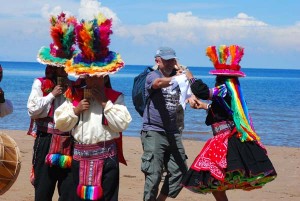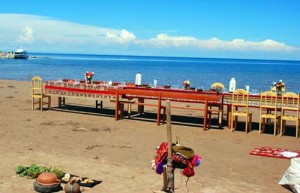Every cultural adventure to Machu Picchu and Peru must be complemented with a Cultural Immersion private tour to the crystal clear waters of Lake Titicaca. The lake is located on the border of both Peru and Bolivia and is technically the highest navigable lake in the world. It spans approximately 3200 square miles with a depth of 1000ft and contains numerous beautiful islands. This lake is also particularly important to understanding the Incan civilization as it was believed to be the birthplace of the first Incas, Manco Capac and his sister Mama Ocllo, who were the children of the Sun God and Moon. The Incas rose from Lake Titicaca to go forth and bring order and civility to the common people; thereby, creating the beginning of the Incan Empire. Therefore, this lake continues to hold profound spiritual and cultural importance to the Andean people.
The lake is home to some intriguing cultural gems, one being the Floating Islands of Uros. These are a group of approximately 50 islands that are made completely of tortora reeds, a water plant that grows in the lake, making the islands float. Other items necessary for daily use are also made from reeds including, the houses, boats and furniture etc. Due to the rise of tourism and the interest in these islands as well as the tribe, the people now have easy access to a church, medical clinic and school, which are located on the islands. However, historically, they used to live in isolation.
The Uros people are one of the oldest tribes in South America, far surpassing the Incan civilization, with genetic roots from Polynesia. They call themselves kot-suña, the people of the water, and the name Uros supposedly comes from their first habitat around Lake Uro-Uro, in Bolivia. It is believed that they moved to Lake Titicaca due to the abundance of tortora reeds and lived on floating islands to protect themselves from conquering civilizations who sought to utilize the fertile altiplano around the lake. Over time they have mixed with the indigenous Aymara population and have adopted their language and some of their traditions. Additionally, the islands have moved closer to Puno in Peru due to environmental events.
In 1970, the culture and lifestyle of the people of Uros was rapidly diminishing as many moved to the mainland in pursuit of different opportunities and those who were left on the island were elderly. This was also the year when the last speaker of the original Uros language died. However, by the end of the 20th Century the people of Uros began to reestablish their traditions and lifestyle with the rise of tourism in Peru. They found a lucrative source of income by remaining on the islands and revisiting their traditional way of life. They expanded and created more islands as the people moved back to the lake. Today, the islands see a significant number of daily tourists and the people provide explanations about the construction of the islands, their independent governance system and traditions. They allow people to see inside their reed houses, and take tourists for a paddle in their reed boats around the islands. It`s a truly unique and fascinating experience.
Further into the lake, you will find a natural treasure of true beauty, Taquile Island. Located 35km from Puno, this island lay relatively isolated until the 1970s when the first tourists began to arrive. This colorful and island is not only appealing to the eye with its cobblestone paths, spectacular lake views and agricultural terraces, it also has a very tranquil and peaceful way of life. It is an island where community comes before anything else as they continue to strongly practice indigenous traditions and customs. The people wear traditional clothing and primarily speak Quechuan. They continue to practice community collectivism and follow the Incan moral code being “ama sua, ama llulla, ama qhilla”, which is Quechua for “do not steal, do not lie, do not be lazy”. There is also no police presence on the island as crime is very rare and dealt with during community congregations. The majority of people are Catholic but have intertwined their native beliefs into this religion with the continued belief of Patchamama, mother earth, who directly controls harvesting and fertility. This island is also famous for their fine hand-woven textiles and clothing, which are regarded among the highest quality handicrafts in Peru. Knitting is exclusively performed by males, whereas women exclusively make yarn and weave.
To discover these two gems in Lake Titicaca, you can take a private tour with Cultural Immersion. You will be met at your hotel by a private English speaking guide who will accompany you to the port and stay with you for the rest of your tour. You will explore the floating Uros islands and meet the people who live on the islands. You will learn about the islands and their way of life, see their houses and be treated to a tortora reed boat ride through the islands.
You will then relax and enjoy the lake scenery on a 2 hour private motorized boat ride, with your guide, to a private white sand beach on Taquile Island. Here, you will enjoy a locally prepared lunch of fresh Lake Titicaca trout while overlooking the beautiful waters of the lake. After lunch, you will have the opportunity to explore the island with your guide, who will tell you about the history, the different stories and point out the interesting features along the way.
To really experience the culture of the island, you may decide to spend the night in a local hut where you will enjoy a delicious meal, usually consisting of soup, fish, rice, vegetables and tea. The hut will be basic lodgings but it`s the best way to really enjoy the tranquility of the island, relax from a busy travel schedule and watch the amazing sunrise over Lake Titicaca.
By Annie Rutherford







Recent Comments